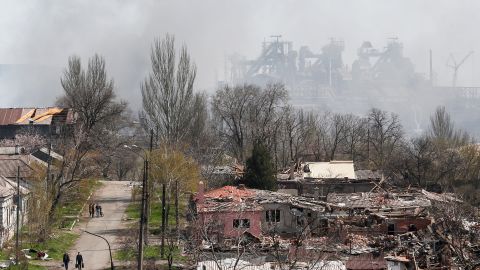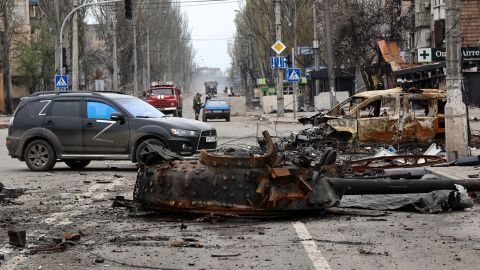‘They never expected Mariupol to resist.’ Locals horrified by Russia’s
Lviv, Ukraine — Few beyond the metals industry had heard of Mariupol’s Azovstal Steel and Iron Works before it became the scene of a desperate last stand against Russia’s invading forces.
Until recently Azovstal was a major player on the global stage, producing 4 million tons of steel annually and exporting the majority across the globe, according to its owner Metinvest Holding, Ukraine’s biggest steelmaker.
From London’s Shard skyscraper to Hudson Yards in Manhattan to Genoa’s San Giorgio Bridge (which replaced the collapsed Morandi Bridge), steel produced at Azovstal is used in some of the world’s most recognizable landmarks.
But for weeks now, the world has been gripped by the battle raging over the steelworks on the coast of the Sea of Azov.
The pocket of Ukrainian fighters entrenched at the plant has become a symbol of the country’s unwavering resistance in the face of an enemy that far outnumbers them.
Yuriy Ryzhenkov, CEO of Metinvest Holding which owns the plant, is devastated by what he sees happening to the plant and to Mariupol.
“The city’s literally under siege for almost two months now. And the Russians, they don’t allow us to bring food into the city or water into the city,” Ryzhenkov says.
“They’re not allowing us to take the civilians out of the city in a centralized manner. They make the people either move out in their own automobiles or even walk by foot through the minefields. It’s a humanitarian disaster there.”
Asked why Russian President Vladimir Putin wants to take Azovstal so badly, Ryzhenkov tells CNN, “I don’t think it’s the plant that he wants.”
“I think it’s about the symbolism that they wanted to conquer Mariupol. They never expected Mariupol to resist.”
At least 150 employees have been killed and thousands remain unaccounted for, he says.

“What we know is that out of the 11,000 employees at Azovstal,” says Ryzhenkov, “only about 4,500 people got out of Mariupol and got in contact with us so we know their whereabouts.”
He seems haunted by the fate of Azovstal’s workforce.
“For the last two months, the whole company tried to do anything possible to get the people to the safety. Unfortunately, at the moment, we’re still not even half-way there.”
The company’s staff includes family dynasties who have made steel for as long as they can remember.
Ivan Goltvenko, a 38-year-old human resources director at the plant, is the third generation of his family to work at Azovstal.
“I hoped I would work for Azovstal all my life and will contribute a lot to the fabric and to my city,” he says sadly.
“Seeing your city being destroyed is horrible, You could compare it to a relative dying in your arms … And seeing him or her dying gradually, organ after organ failing, and you can do nothing.”
From the city of Zaphorizhzhia, he finds it hard to watch the scale of the devastation wrought by Russian airstrikes “because you want your city to remain the same as it was in your memory.”
News of what’s happening back home is filtering through from friends and colleagues who are still trapped in Mariupol.
“Today, for example, I was shown a video of my apartment. Despite the fact that the house survived, my flat is completely looted by Russian soldiers. Nothing valuable was left – they even rummaged among the children’s toys, and many of them were stolen.”

He says he spoke to one colleague on April 24 who revealed some of the horrors with which residents are being confronted.
“From one of the employees, who has a connection, we know that he is in the city, he didn’t manage to leave, and he has been involved in debris removal and transporting the bodies of dead citizens,” Goltvenko says.
“And yesterday he told me that for one day from only one district of the city, I would even say ‘from only one street’ he loaded four trucks of bodies.
“He said: ‘I was drawn to volunteering at the morgue to collect bodies in the city and take them away.’”
“For that,” says Goltvenko, “he receives a dry ration.”
His colleague, 49-year-old Oleksiy Ehorov, Deputy Head for Repairs, has lived in Mariupol since he was a child.
“I studied there, I started working there, there I’ve become the person who I am now. And seeing how it has been destroyed … You can’t tell it without tears, without a lump in the throat,” he says.
The…
Read More: ‘They never expected Mariupol to resist.’ Locals horrified by Russia’s

